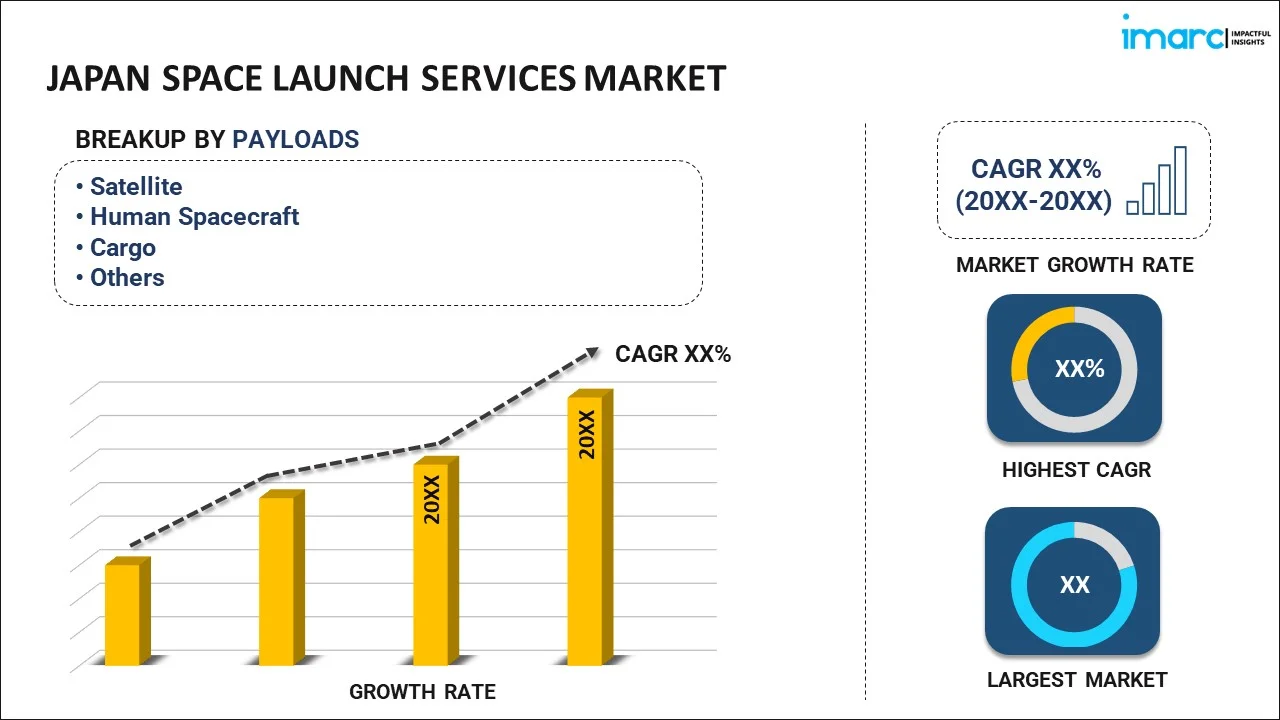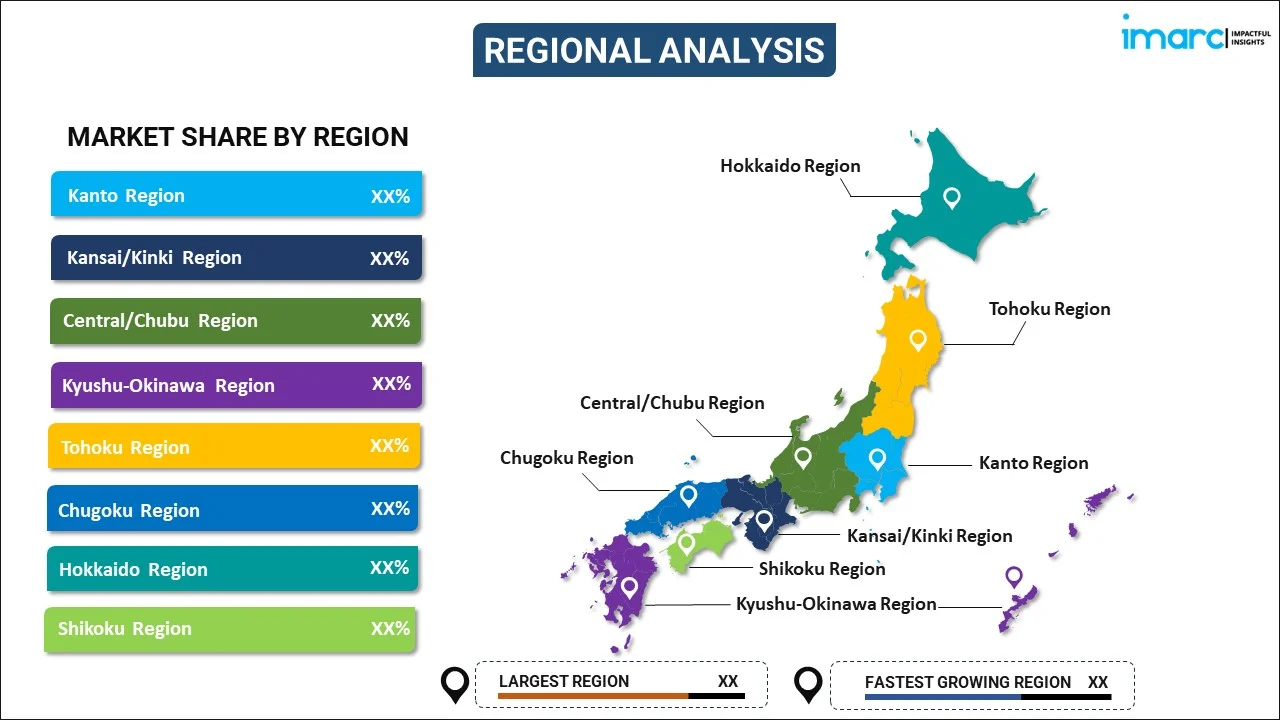
Japan Space Launch Services Market Report by Payload (Satellite, Human Spacecraft, Cargo, Testing Probes, Stratollite), Launch Platform (Land, Air, Sea), Service Type (Pre-Launch, Post-Launch), Orbit (Low Earth Orbit (LEO), Medium Earth Orbit (MEO), Geosynchronous Orbit, Polar Orbit), Launch Vehicle (Small Launch Vehicle, Heavy Launch Vehicle), End User (Government and Military, Commercial), and Region 2025-2033
Market Overview:
Japan space launch services market size reached USD 968.8 Million in 2024. Looking forward, IMARC Group expects the market to reach USD 4,421.7 Million by 2033, exhibiting a growth rate (CAGR) of 18.3% during 2025-2033. The rising number of space exploration activities and the continuous technological advancements by leading players are primarily bolstering the regional market.
|
Report Attribute
|
Key Statistics
|
|---|---|
|
Base Year
|
2024
|
|
Forecast Years
|
2025-2033
|
|
Historical Years
|
2019-2024
|
|
Market Size in 2024
|
USD 968.8 Million |
|
Market Forecast in 2033
|
USD 4,421.7 Million |
| Market Growth Rate 2025-2033 | 18.3% |
Space launch, also known as lift-off, denotes the initial phase of operations where rockets or other vehicles, including airborne aircraft and floating ships, are vertically launched from the ground. This phase encompasses a sequence of activities, such as coordination, communication, stacking, assembly, and payload integration, aimed at reducing launch costs and ensuring a seamless lift-off. These processes are crucial for preparing spacecraft for launch, making space launch services indispensable for government entities, space organizations, and military agencies engaged in space explorations. Currently, these services are classified into pre-launch and post-launch stages.
Japan Space Launch Services Market Trends:
The Japan space launch services market is experiencing substantial growth, driven by the widespread adoption of these procedures across commercial, government, and military and defense sectors. This surge in demand is primarily fueled by the increasing number of aircraft and satellite testing during launches, which is acting as another significant growth-inducing factor. Notably, significant technological advancements, such as the integration of miniaturization in electronic systems to enhance small satellite capabilities by reducing the size of various integrated electronics and hardware, serve as a key growth factor. Besides this, the adoption of the commercial-off-the-shelf (COTS) approach further supports this trend, enabling space companies to employ miniaturization methodologies for collecting distributed data and experimentation purposes, which is positively influencing the regional market. Furthermore, the market is witnessing a shift in preference among space launch service providers toward smaller satellites over traditional ones. This strategic move allows for faster development and lower launch costs. The rising demand for low earth orbit (LEO)-based services, particularly in areas such as imagery-based intelligence and space-based communication, adds to the market's momentum. Additionally, substantial investments in research and development (R&D) activities geared toward designing, maintaining, and operating commercial payload facilities will contribute positively to the overall market outlook in Japan over the forecasted period.
Japan Space Launch Services Market Segmentation:
IMARC Group provides an analysis of the key trends in each segment of the market, along with forecasts at the country level for 2025-2033. Our report has categorized the market based on payload, launch platform, service type, orbit, launch vehicle, and end user.
Payload Insights:

- Satellite
- Small Satellite (Less Than 1000 Kg)
- Large Satellite (Above 1000 Kg)
- Human Spacecraft
- Cargo
- Testing Probes
- Stratollite
The report has provided a detailed breakup and analysis of the market based on the payload. This includes satellite (small satellite (less than 1000 Kg) and large satellite (above 1000 Kg)), human spacecraft, cargo, testing probes, and stratollite.
Launch Platform Insights:
- Land
- Air
- Sea
A detailed breakup and analysis of the market based on the launch platform have also been provided in the report. This includes land, air, and sea.
Service Type Insights:
- Pre-Launch
- Post-Launch
The report has provided a detailed breakup and analysis of the market based on the service type. This includes pre-launch and post-launch.
Orbit Insights:
- Low Earth Orbit (LEO)
- Medium Earth Orbit (MEO)
- Geosynchronous Orbit
- Polar Orbit
A detailed breakup and analysis of the market based on the orbit have also been provided in the report. This includes low earth orbit (LEO), medium earth orbit (MEO), geosynchronous orbit, and polar orbit.
Launch Vehicle Insights:
- Small Launch Vehicle
- Heavy Launch Vehicle
The report has provided a detailed breakup and analysis of the market based on launch vehicle. This includes small launch vehicle and heavy launch vehicle.
End User Insights:
- Government and Military
- Commercial
A detailed breakup and analysis of the market based on the end user have also been provided in the report. This includes government and military and commercial.
Regional Insights:

- Kanto Region
- Kansai/Kinki Region
- Central/ Chubu Region
- Kyushu-Okinawa Region
- Tohoku Region
- Chugoku Region
- Hokkaido Region
- Shikoku Region
The report has also provided a comprehensive analysis of all the major regional markets, which include Kanto Region, Kansai/Kinki Region, Central/ Chubu Region, Kyushu-Okinawa Region, Tohoku Region, Chugoku Region, Hokkaido Region, and Shikoku Region.
Competitive Landscape:
The market research report has also provided a comprehensive analysis of the competitive landscape. Competitive analysis such as market structure, key player positioning, top winning strategies, competitive dashboard, and company evaluation quadrant has been covered in the report. Also, detailed profiles of all major companies have been provided.
Japan Space Launch Services Market Report Coverage:
| Report Features | Details |
|---|---|
| Base Year of the Analysis | 2024 |
| Historical Period | 2019-2024 |
| Forecast Period | 2025-2033 |
| Units | Million USD |
| Scope of the Report | Exploration of Historical Trends and Market Outlook, Industry Catalysts and Challenges, Segment-Wise Historical and Future Market Assessment:
|
| Payloads Covered |
|
| Launch Platforms Covered | Land, Air, Sea |
| Service Types Covered | Pre-Launch, Post-Launch |
| Orbits Covered | Low Earth Orbit (LEO), Medium Earth Orbit (MEO), Geosynchronous Orbit, Polar Orbit |
| Launch Vehicles Covered | Small Launch Vehicle, Heavy Launch Vehicle |
| End Users Covered | Government and Military, Commercial |
| Regions Covered | Kanto Region, Kansai/Kinki Region, Central/ Chubu Region, Kyushu-Okinawa Region, Tohoku Region, Chugoku Region, Hokkaido Region, Shikoku Region |
| Customization Scope | 10% Free Customization |
| Post-Sale Analyst Support | 10-12 Weeks |
| Delivery Format | PDF and Excel through Email (We can also provide the editable version of the report in PPT/Word format on special request) |
Key Questions Answered in This Report:
- How has the Japan space launch services market performed so far and how will it perform in the coming years?
- What has been the impact of COVID-19 on the Japan space launch services market?
- What is the breakup of the Japan space launch services market on the basis of payload?
- What is the breakup of the Japan space launch services market on the basis of launch platform?
- What is the breakup of the Japan space launch services market on the basis of service type?
- What is the breakup of the Japan space launch services market on the basis of orbit?
- What is the breakup of the Japan space launch services market on the basis of launch vehicle?
- What is the breakup of the Japan space launch services market on the basis of end user?
- What are the various stages in the value chain of the Japan space launch services market?
- What are the key driving factors and challenges in the Japan space launch services?
- What is the structure of the Japan space launch services market and who are the key players?
- What is the degree of competition in the Japan space launch services market?
Key Benefits for Stakeholders:
- IMARC’s industry report offers a comprehensive quantitative analysis of various market segments, historical and current market trends, market forecasts, and dynamics of the Japan space launch services market from 2019-2033.
- The research report provides the latest information on the market drivers, challenges, and opportunities in the Japan space launch services market.
- Porter's five forces analysis assist stakeholders in assessing the impact of new entrants, competitive rivalry, supplier power, buyer power, and the threat of substitution. It helps stakeholders to analyze the level of competition within the Japan space launch services industry and its attractiveness.
- Competitive landscape allows stakeholders to understand their competitive environment and provides an insight into the current positions of key players in the market.
Need more help?
- Speak to our experienced analysts for insights on the current market scenarios.
- Include additional segments and countries to customize the report as per your requirement.
- Gain an unparalleled competitive advantage in your domain by understanding how to utilize the report and positively impacting your operations and revenue.
- For further assistance, please connect with our analysts.
 Inquire Before Buying
Inquire Before Buying
 Speak to an Analyst
Speak to an Analyst
 Request Brochure
Request Brochure
 Request Customization
Request Customization




.webp)




.webp)












